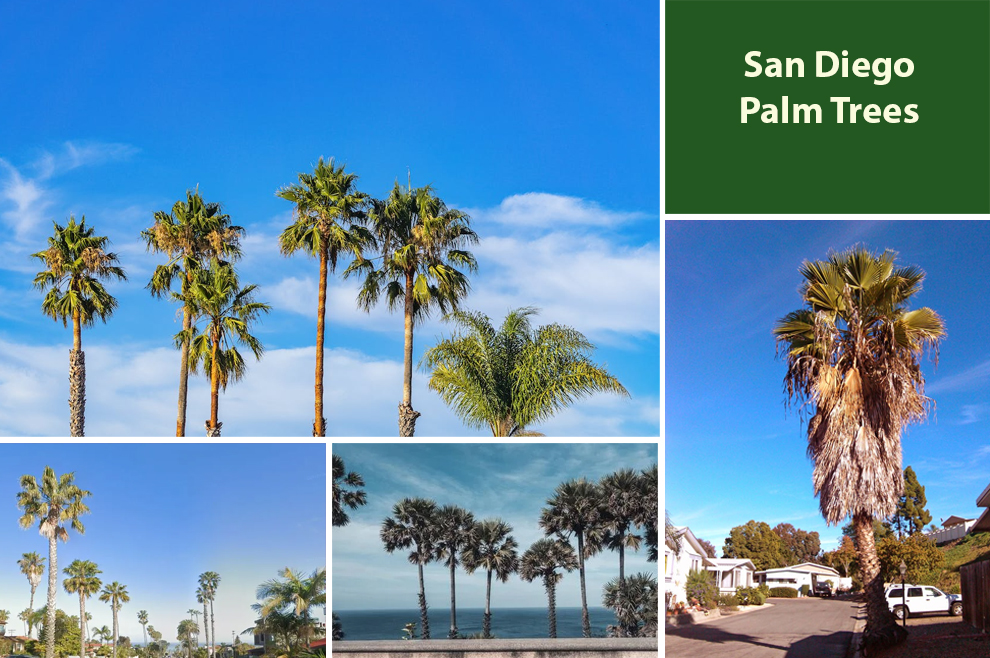Different Types of San Diego Palm Trees
San Diego’s ideal climate and coastal location create a haven for a diverse array of palm trees from various corners of the globe. Whether it’s the towering Canary Island Date Palm or the elegant California Fan Palm, each species adds its unique charm to the city’s landscape.

San Diego, a city renowned for its stunning coastal beauty and year-round mild climate, is a paradise for palm tree enthusiasts. The diverse range of palm trees gracing the city’s landscape adds to its allure and tropical charm.
From elegant royal palms to striking California fan palms, San Diego offers a rich tapestry of palm species that flourish in its Mediterranean-like climate.
In this article, we will explore the various San Diego palm trees that thrive in this beautiful city.
Where Are San Diego Palm Trees From?
San Diego’s palm trees come from various regions around the world, as they have been introduced and cultivated over the years for their ornamental value and ability to thrive in the city’s Mediterranean-like climate.
Many of the palm tree species in San Diego are not native to the region but have been planted extensively in parks, streets, gardens, and public spaces to create a tropical and exotic ambiance.
Some of the most common palm tree species in San Diego and their origins include:
- Canary Island Date Palm (Phoenix canariensis): Native to the Canary Islands off the northwest coast of Africa.
- Mexican Fan Palm (Washingtonia robusta): Native to northwestern Mexico.
- California Fan Palm (Washingtonia filifera): Native to California and the southwestern United States.
- Queen Palm (Syagrus romanzoffiana): Native to South America, including Argentina and Brazil.
- Date Palm (Phoenix dactylifera): Native to the Middle East and North Africa.
- Mediterranean Fan Palm (Chamaerops humilis): Native to the Mediterranean region, including Southern Europe and North Africa.
- Mexican Blue Palm (Brahea armata): Native to Baja California in Mexico.
- Sago Palm (Cycas revoluta): Native to Japan.
- Sylvester Palm (Phoenix sylvestris): Native to India and Southeast Asia.
- Bismarck Palm (Bismarckia nobilis): Native to Madagascar.
Types of Palm Trees In San Diego
Let’s discuss some of the popular kinds of palm trees that you can easily spot in San Diego.
A. Canary Island Date Palm (Phoenix canariensis)
One of the most iconic palm trees in San Diego is the majestic Canary Island Date Palm. With its towering height and massive crown of feathery fronds, this palm lends an air of grandeur to the cityscape.
The palm’s distinctive pineapple-like trunk adds to its aesthetic appeal, making it a popular choice for urban landscapes and parks. More on Canary Palm and its growth rate here.
B. Mexican Fan Palm (Washingtonia robusta)
The Mexican Fan Palm is a common sight in San Diego, gracing streets and avenues with its slender trunk and fan-shaped leaves.
Mexican fan palms are not very high maintenance. Tolerant to coastal conditions and drought, it is an ideal choice for coastal areas and seaside neighborhoods.
C. California Fan Palm (Washingtonia filifera)
The native California Fan Palm is a symbol of the region’s unique natural beauty. It can be found in various areas around San Diego, including canyons and oases.
With its picturesque silhouette and fan-like leaves, it creates a striking contrast against the city’s skyline.
D. Queen Palm (Syagrus romanzoffiana)
The graceful Queen Palm is a favorite for landscaping in San Diego due to its elegantly arching fronds and ornamental orange fruit clusters.
We have a guide here for you on how to grow queen palms. It thrives in the city’s warm climate, adding a touch of tropical elegance to residential areas.
E. Date Palm (Phoenix dactylifera)
Known for its delicious and nutritious fruit, the Date Palm species graces gardens and public spaces throughout San Diego. Its tall, slender trunk and feathery fronds contribute to its enchanting appearance.
F. Mediterranean Fan Palm (Chamaerops humilis)
This compact and cold-hardy palm is well-suited for San Diego’s coastal environment.
With its multi-trunk growth habit and fan-shaped fronds, the Mediterranean Fan Palm is an excellent choice for small gardens and tight spaces.
G. Mexican Blue Palm (Brahea armata)
The striking blue-gray fronds of the Mexican Blue Palm add a touch of exotic beauty to San Diego’s landscapes.
It thrives in the city’s warm climate and well-draining soils, making it a popular choice for both residential and public spaces.
H. Sago Palm (Cycas revoluta)
Though not a true palm, the Sago Palm variety is often mistaken for one due to its palm-like appearance.
It is a popular ornamental plant in San Diego’s gardens, offering a tropical look with its feathery fronds and stout trunk.
I. Sylvester Palm (Phoenix sylvestris)
The Sylvester Palm is prized for its symmetrical crown and silvery-blue fronds. It can be found adorning streets, parks, and golf courses throughout San Diego, adding a touch of elegance to the landscape.
J. Bismarck Palm (Bismarckia nobilis)
This stunning palm with its large, fan-shaped silver-blue fronds is a showstopper in San Diego’s botanical gardens and upscale neighborhoods. It is well-suited for spacious landscapes where its grandeur can be fully appreciated.
You might also like to know about Palm Trees in – Arizona | Hawaii | Miami | Texas | South Carolina | California | Alabama | Australia | Brisbane | Florida
What Is The Oldest Palm Tree In San Diego?
One of the oldest and most iconic palm trees in San Diego is the “Heritage Palm” (also known as the “Big Palm”) located in Balboa Park. It is a Canary Island Date Palm (Phoenix canariensis) and is estimated to be around 100 years old.
Please note that there might be other historic palm trees in San Diego that are equally old or even older, but the Heritage Palm is particularly well-known and celebrated for its age and significance in the city’s history.
